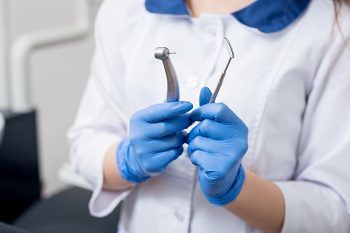Deep Dental Cleaning Procedure
A deep dental cleaning procedure is a gum therapy used to deeply clean the patient’s teeth, gums, and roots. It uses special techniques that promote gum healing and treat periodontal issues like bad breath or swollen gums.

Usually, a dentist recommends this treatment to those who suffer from gum disease or have excess tartar, plaque, and bacteria in the mouth. At first, the dentist takes an X-ray of the patient’s mouth to assess the condition of his oral health. The procedure is done if they consider them a suitable candidate for deep dental teeth cleaning.
The main dental deep teeth cleaning procedure consists of two basic steps, i.e., scaling and root planing. Scaling is done to remove tartar and plaque from below the gumline. In contrast, root planing aims to clean the roots by removing any buildups to protect the teeth. The deep dental teeth cleaning procedure is divided into three steps discussed below.
1. Measuring Gum Pocket Depth
First, the dentist assures that a patient is suitable for the treatment. He examines his medical history and performs an X-ray to ensure this fact. Then, the patient’s gum pockets are inspected for any possibilities of periodontitis or gingivitis.
The dentist uses a dental probe to determine the depths of the gum pockets. Pockets deeper than 4mm usually indicate periodontitis, whereas they suggest a healthy mouth if they are between 1-3mm. After measuring the depths, the patient is then prepared for teeth scaling.
2. Dental Scaling

Dental scaling is also known as gum scaling or perio-scaling. It is the first part of deep dental teeth cleaning. Teeth scaling is used to remove all the tartar or plaque that is accumulated in the patient’s mouth. It is mostly done within a 1–2-hour visit to the dentist.
Teeth scaling involves a scraping method to remove excess buildups from the patient’s mouth. The dentist might use an ultrasonic tool for this procedure. Afterward, the patient’s teeth are polished by applying an air polisher.
3. Root Planing
Lastly, it is the root planing step. Here, the roots of the teeth are deeply cleaned to assure gums get reattached with the teeth. The dentist can use a mild sedative for carrying out the procedure.
Is the Procedure Painful?
The majority of the time, any discomfort caused by the procedure is tolerable. Individuals with extremely deep pockets, on the other hand, will suffer more than others. Similarly, those with sensitive teeth may experience intense pain. As a solution, a dentist will use a local anesthetic as needed. It helps to numb the region surrounding your gums.
Conclusion
Dental deep teeth cleaning is an effective method to treat unhealthy gums. The procedure mostly involves 2-3 dental sittings in which the patient’s teeth are deeply cleaned to promote better oral health. The process is usually bearable for most of the patients.
However, slight discomfort can be associated during and after the procedure. So, the patients are recommended to avoid hard, hot, cold, or crunchy foods and take special care while brushing. If you want to avail yourself of this treatment, visit your dentist right away to get its maximum benefits.
Contact your Danville dentist, Dr. Hoss Abar, DDS, MSD at Danville Orthodontics now to schedule your appointment.
*Neither this nor any other content in this media is meant to prescribe, recommend, or prevent any treatment or procedure. We highly recommend that you get the advice of a qualified dentist or other medical practitioners regarding your specific dental condition.
